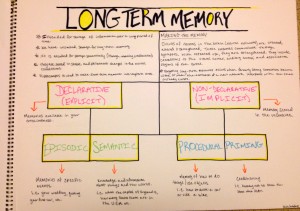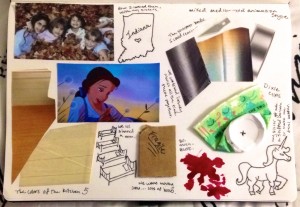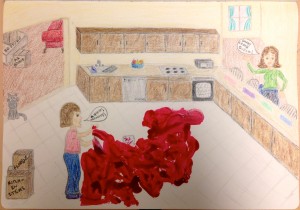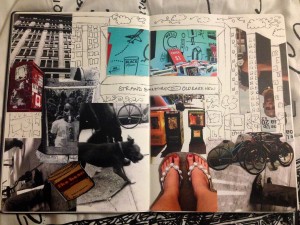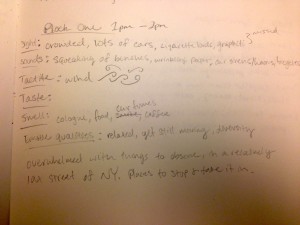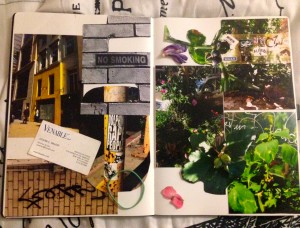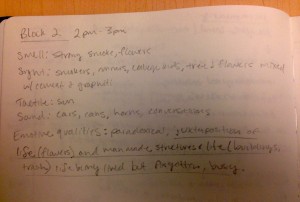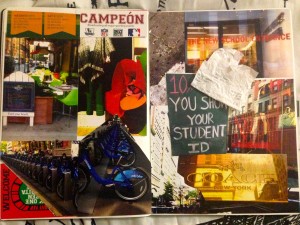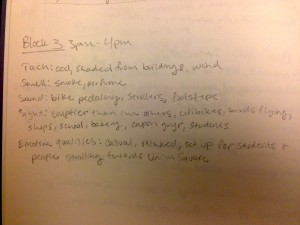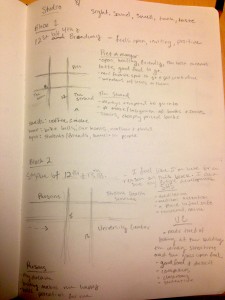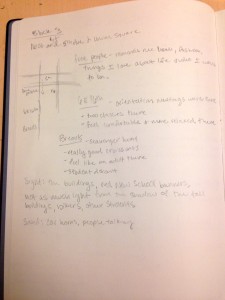Long Term Memory is intended to store information for over a long period of time. We have an unlimited amount of long term memory. These memories are encoded into our brains semantically – based on meaning and association. The process of making the memory consists of circuits of neurons, also known as neural networks, are created, altered, and/or strengthened in this process. These networks communicate through synapses, and with repeated use, these synapses are strengthened. These networks have connections to the visual cortex, auditory cortex, and associative regions of the cortex. These memories are not stored the same way short term memories are stored. Long term memories are stored in more stable and permanent changes in the neural networks spread throughout the brain. Short term memories can become long term memories though. The Hippocampus is used to move short term memories into long term memories. Forgetting, or not being able to recall long term memories occur because a once strong synapse is now weak, or because a new neural network has interfered with the one that already exists. Long Term Memory can be broken down into sub categories called Declarative (Explicit) – memories stored in your consciousness – and Non-Declarative (Implicit) – memories stored in your unconsciousness. Declarative can then be broken down into Episodic memory – the memories of specific events – and Semantic memory – memories of knowledge and information about the world. Likewise, Non-Declarative Memory can be split into Procedural memory – such as how to drive a car or ride a bike – and Priming/Conditioning, which is when you have learned to automatically associate stimuli together. For instance, you know not to touch a hot stove.
Monthly Archives: September 2014
MoMA Response
Spending time at the Museum of Modern Art opened my eyes up to the amount of intention and work behind each art piece. As a younger teen, I never really gave modern art a chance. Now, more mature and more of an artist myself, I could tell these works of art told stories that I had never thought of before. I came to realize that it is important to learn more about the artist, their background, and the type of art that they are demonstrating in order to fully appreciate the art in front of me . One exhibit that spoke to me in a new way was the exhibition of Henri de Toulouse-Lautrec. His lithographs were representations of his memories of Paris at the time. Knowing this, the exhibit came to life in a new way. They were no longer just depictions of french women and men dancing or reading, I realized that these were real people – living and breathing at one point in time. Not only that, but these were Lautrec’s perception of them, which is interesting because you can learn more about Lautrec by looking at his depictions of others. These lithographs also show interesting elements of the memory. These memories of Lautrec’s now belong to future generations and how they will remember Paris at that time. Learning about the long and practiced art of lithographing also gave a new appreciation to the works in front of me. When looking at one of the works as a whole, it is beautiful enough, but once a person knows that each color in the picture depended on a new layer of ink and that most of the shapes, like heads, were created out of negative space, the audience can appreciate Lautrec’s work even more fully. Taking this new outlook and zeal with me, I explored rest of the museum and I even became intrigued in a new way by the works of Andy Warhol and Jason Pollock. It made me want to go home and do some more research on the intention behind their works and lives.
Marwencol Response
Mark Hogencamp uses his alternate doll world, named Marwencol, to cope with his loss of memory by playing out his emotions and coping processes through the alternate lives of the dolls. As he continues on his journey of recovery, he expresses his realizations, desires and flashbacks through this art craft. The photographs he takes of these dolls captures the human emotions in a a new and realistic way, that contradicts the artificial characteristics of the dolls. Through this, he creates very personal relationships with his dolls and creates new memories with them to compensate for the lost ones. For instance, since Hogencamp no longer remembers his real ex-wife and their marriage, he has created a very real relationship with his ideal “woman,” Anna, and created a marriage between her doll and his doll. Watching Hogencamp interact with the dolls, and seeing his genuine care and love for them was incredibly impactful. The vulnerability shown in the documentary and the sincerity put into his work and the progress he was trying to make was touching and shone a new light on how our memories form us and who we are. It was interesting to see how Mark rediscovered who he was in a way. For example, he didn’t realize that the women’s shoes in his apartment were his and that he liked to wear them. His memory of the attack had an enormous impact on him and his confidence in wearing them again. Once again, this shows how our memories have such a strong affect on our future behavior. With this new outlook, it is interesting to look back even on my more minute memories and how they have affected who I am today. I am going to take this new outlook as I approach my own memories and the way I articulate them in my work.
Memory Reconstructed
A distinct childhood memory that has always vividly stuck with me is one that is not the most pleasant. It is one of the oldest memories I have and I remember it in snapshots, sort of like Mark Hogencamp does with his brief memories of life before his attack. After confirming with my mother that it was a real memory, and not some strange dream that fooled me into believing it was real, we determined that I was only about four years old when it happened. My family and I were still living in Indiana, in a small apartment that we were about to move out of. One day, I can’t remember why, but for some absurd reason, I was set upon creating a hole through the waxy bottom of a paper Dixie Cup. In my four year old logic, I decided that I should use the sharpest knife I could find, which just happened to be a steak knife. As I successfully created the desired hole, I suddenly realized that there was blood all over the floor and looking down at my hand, I saw that I had badly cut open my hand with the cup. I hadn’t even felt the pain, but horrified at the sight, I screamed and my mother came rushing into the kitchen. She promptly took me to the hospital and they bandaged my hand up. I remember coming home to my three sisters waiting outside our door with welcome home signs. In order to comfort me, my youngest sister gave me a stuffed unicorn of hers that I had always wanted.
The frame that I will be composing, in an old animated cartoon style, for my memory, will feature me in the kitchen with the knife and cup, surrounded by blood and my mother will be entering the room. My sister will be in the background with her unicorn stuffed animal and I will use speech bubbles to convey rest of the thought processes and words. In this way, I can show the whole memory and still keep it simple, but interesting, along with sticking to the overall style of the project.
Memory Reconstructed: Final Frame Product
For the final project of reconstructing the memory, I decided to draw the experience in the same style as a cartoon or animated movie. Though I have never attempted this style of drawing before, I think it helps capture the childlike nature of the memory since I was so young. It is almost reminiscent of a child’s storybook. In the frame, I decided to exaggerate things such as the amount of blood on the floor and the size of the kitchen. This is because in my child like mind, everything seemed bigger to me at the time compared to how it actually was. Lastly, I decided to use red nail polish for the blood in order for it to stand out more and capture the audience’s attention more because the blood is what sticks out to me in my own memory the most.
The Flaneur: Part 2
The Flaneur: Part 1
The beginning of The Flaneur process started with these block reflections from memory.
After having done these reflections, I figured there wasn’t much I missed because I walk these blocks everyday on the way to classes, and I have found them to be some of my favorite blocks in the city.
Telescoping the Microscopic Object: Questions & Responses
1. How did Benjamin view the importance and the role of ‘the collector?’
Benjamin views the role of the collector as someone who sees the value of an object detached from it’s consumer driven purpose, and instead sees the memories and questions raised about humanity associated with it. According to Benjamin, a collector’s relationship with his or her objects allows him/her “access into origin and past, but also into the future, into prospective worlds and future modes of dealing with objects.” (pg. 70) This special view of things and the world in relation to them, gives the collector a special way of critiquing the material world around them.
2. What, according to Benjamin, is a ‘flaneur’? What is its significance?
A flaneur is somewhat of a city wanderer and his private and public part in the city are one in the same. It is a person who collects everyday trash and waste and gives them new value. A flaneur is “not just one man in the crowd, but was a part of the crowd.” (pg. 85) This unordinary way of life allows the flaneur a unique view on the changing city around them and the material world.
3. How do objects and the spaces they inhabit help us to see more closely and anew? How do they shape our idea of memory and collective histories?
A collective memory can be found in the objects and technology of a certain time period. The objects and products reveal to later generations the collective mind-set and values of the time. Looking at the objects from the past, in the present, knowing how history has unfolded, a new light is shed onto how the object functioned in its time and if it was successful with its intention and purpose.
4. In what ways did Benjamin identify with the Surrealists and their anti-commodity, poetical strategy of data collection from everyday life, dreams, street life, and from the most banal of environments?
He related with the Surrealists because he believed that the Surrealists, “focused on the everyday not in order to smother everything with a blanket of boredom, but to rediscover the eccentricity of the humdrum.” (pg. 72) The Surrealists were an example of Benjamin’s idea of dream-like, child-hood collecting, but in an artistic form. They, too, took the everyday objects and discovered a new meaning and collective unconscious within it.
5. When photography and film were emerging visual technologies, Benjamin introduced the term ‘optical unconscious.’ What did he mean by this? How does photography and film both reflect and construct the world around us?
Benjamin uses the term “optical unconscious,” to describe a way of relaying to rest of the world a perception of something through photography and film. This means that, although a picture may contain truth, a new way of viewing it comes into play for the audience now that a moment of real time has been frozen and taken out of context. Photographs and films can reflect the world by forcing us to look at what is going on around us, but it can also form a specific view on what is going on around us as well because it “ruptures life’s continual flow of images….as representation, it is held up, made still for an instant of conscious reflection on its significance.” (pg. 62)
